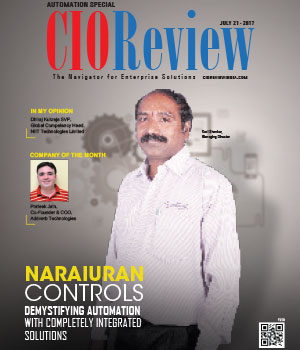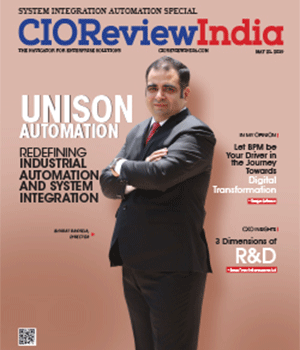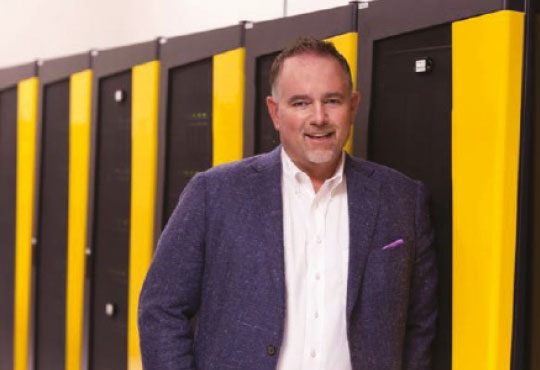
Top 5 Promises We Hear When Evaluating Hyperconverged Infrastructure
Kaustubh Das, VP of strategy and product management, storage for Cisco's Computing Systems Product Group, Cisco | Wednesday, 23 August 2017, 13:06 IST
 Enterprises are seeking a simpler approach to taming the bird’s nest that is today's IT infrastructure. They are turning to a hyperconverged infrastructure (HCI) approach that not only streamlines deployments across compute, storage and networking, but also helps infrastructure scale linearly as needs grow while unifying and simplifying management and maintenance. While there are point solutions that bring some of these elements together, an HCI strategy that is not interoperable with your current data center may add more complexity to the problem it intends to solve.
Enterprises are seeking a simpler approach to taming the bird’s nest that is today's IT infrastructure. They are turning to a hyperconverged infrastructure (HCI) approach that not only streamlines deployments across compute, storage and networking, but also helps infrastructure scale linearly as needs grow while unifying and simplifying management and maintenance. While there are point solutions that bring some of these elements together, an HCI strategy that is not interoperable with your current data center may add more complexity to the problem it intends to solve.
Before choosing an HCI solution, determine whether it has your data center architecture’s needs in mind, or if you’ve fallen prey to some of the recent myths plaguing the buying process. As organizations consider how HCI fits within the digitization of business, consider the following myths keeping you from attaining a more complete HCI outcome.
CAPEX is the Primary Driver for TCO Savings
Enterprises are trapped amongst a myriad of incomplete HCI solutions that place a premium on upfront costs, but it’s the journey after installation that matters. When harnessing the power of any disruptive technology like HCI, time is money. And time can be lost if an HCI strategy does not consider the implications three to four years down the road.
"Regardless of which solution is used, a seamless combination of networking, compute and storage is key to building efficient and homogenous systems"
To take advantage of a complete HCI solution, CIOs must consider a solution’s ability to reduce complexity by automating policy and scaling capabilities, while also maintaining low latency and high performance. HCI solutions with built-in policy-driven automation features can offer simpler installation, configuration and management processes now and in the future. Time and money are wasted when the promise of initial investment savings also includes manual maintenance and professional support costs that eventually lead to more operational expenditures.
It’s a matter of tangible costs- upfront CAPEX and reoccurring software subscriptions—versus intangible costs associated with human labor, downtime and other operational factors. Overtime, as newer nodes are added or failing ones replaced to meet future demand, ensure that your systems are properly automated or structured to avoid TCO increase.
Any HCI can Consolidate and Run all Your Enterprise Workloads
While HCI is often billed as simple and flexible, not all workloads can run on most existing HCI solutions. “First-generation” vendors often paint the illusion that HCI solutions are compatible with every type of workload. However, these HCI solutions often lack the characteristics needed to support certain enterprise workloads - especially the ones demanding sustained low latency and high IOPS.
All Flash HCI solution designed from the ground-up with those goals in mind should be critical to selection criteria. The HCI solutions delivering the data optimizations without performance impact are keys to delivering additional consolidation.
Yet, there are workloads that are not suited for HCI. They will run best on either converged or bare metal infrastructure.
Accordingly, a well designed data center architecture need to pick HCI solutions that can operate alongside traditional converged and legacy infrastructure - within a unified management environment, shared policy and a shared networking fabric. This allows the HCI solution to take on workloads that are well suited for HCI and leave behind workloads that are appropriate for traditional converged infrastructure (CI).
HCI will Break down all Data Center Silos
HCI has emerged as a leading datacenter infrastructure solution to meet these changing expectations. That said, IT will need to provision a bi-modal operating model that support existing legacy applications as well as caters to emerging needs. This implies that HCI will need to be deployed into brownfield environments that include traditionally converged and siloed architectures, but also demands a common management platform. IT budgets are also flattening, or in some cases decreasing, putting a premium on efficiency through increased utilization, elastic operations and optimized workforce deployments and workflows.
With this shift in IT demand, HCI tends to fall short due to an incremental focus on single features or elements. Emphasis on simplicity or the delivery of a unified management environment alone is nice but far from a complete solution in HCI, and perhaps even more damaging. It cannot only promise elastic growth within an HCI deployment, but rather transfer some of the benefits of elasticity and efficiency to the CI side. HCI cannot ignore application lifecycles and deployment options that should span HCI as well as traditional CI. It should not ignore workflows in place and operating costs in headcount, but be scalable in both workflow and operation. A new powerful architecture must be proud of its youth, intelligence and simplicity, but also demands a co-existence with, and common management of, legacy infrastructure to seamlessly help the legacy transition over time.
Network Capabilities do not Matter much in Hyperconvergence Architectures
Early entrants in the HCI market tend to view networking as a “bottle neck” to the transition, when in fact it is the foundation for a HCI solution. With workload consolidation and IOPs hungry workloads moving to HCI, the role of network is critical. A capable networking backbone coupled with software architecture that is designed to uniformly utilize the resources spread across the cluster, is key to high performing HCI solution. From replication traffic to application traffic, the nodes must be based on a truly distributed data architecture that harnesses the hardware, networking and QoS policy to avoid developing complexities during installation.
Besides performance, the HCI solution with high level of integration and automation for network function - for traffic segmentation, QoS and instrumentation - is key to delivering a low manageability HCI.
While rapid deployment of HCI is relatively easy to achieve, organizations can potentially run into network configuration and performance challenges following installation. Therefore, when approaching HCI, there’s a critical need for an HCI management paradigm with a policy-driven architecture that transfers attributes to new hardware infrastructure elements as they are added to the deployment. A true HCI architecture delivers simplicity because hardware and software have been designed to work together. Just as public cloud providers have obsessed over and redefined hardware architectures to work with the evolving needs of an entire stack HCI must make the hardware simple for the IT user by deeply engineering it, off loading to it and optimizing it where it matters.
All Hyperconverged Solutions Perform the Same
Although similar in function, no two HCI solutions are alike. For example, some solutions may focus more on software than hardware, or pull in multiple software and hardware components from several sources instead of leveraging an architecture which is purpose-built from scratch, running on validated hardware. Some solutions emphasize a use case for all workloads, versus taking a policy-centric approach for workloads bringing harmony to legacy, traditional CI and HCI architectures. In terms of workload performance, true solutions will consistently support higher virtual machine densities per cluster, whereas other solutions’ performances in these areas may vary and require extra management time.
Regardless of which solution is used, a seamless combination of networking, compute and storage is key to building efficient and homogenous systems. Most importantly, enterprises will need an HCI solution that can evolve as applications and workloads change.
CIO Viewpoint
By Steve Brunker, CIO, LSI Industries
By Joel Austin, CIO, Oncor Electric Delivery
How Is IoT Emerging as Next Technology Mega...
By Prashanta Ghoshal, Director - IT Solutions, Geometric Ltd.
CXO Insights
Addressing the Challenges in Logistics Automation
By Janifha Evangeline
Digitalization - the critical enabler for...
By Rajesh Ramachandran, Global Chief Digital Officer - Process Automation & ABB Ability, ABB
Enterprise-wide Approach Needed for...











